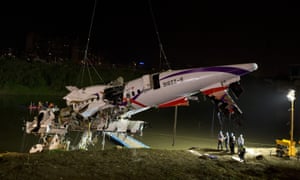我老實說,這篇文章其實我有看沒有懂,讀了兩遍對照圖片還是不懂(機械這塊我資質真的很駑鈍,對不起…)
但我很喜歡這篇文章的重心:不是為了要定誰的罪,而是要找出為什麼會出這樣的問題,避免下次再度發生。這種不輕不重的角度,勢必不會受到現在媒體主管的青睞,說實在,現在的廣大網民閱聽眾似乎也不會買這個帳,但我想說的是,這攸關了這麼多的人命,難道吵過一時、咎責在誰的頭上就結束了嗎?
這比什麼點閱率、媒體道德都來得重要很多很多,這攸關的是我們的每一次飛航安全。
--
後話:
前些日子在臉書上看到朋友說到我們都很愛的美劇The news room第一季第七集,看似收視率主義的Don說了一句經典的話:「只有醫生可以宣布一個人的死亡,媒體不行。」
後話:
前些日子在臉書上看到朋友說到我們都很愛的美劇The news room第一季第七集,看似收視率主義的Don說了一句經典的話:「只有醫生可以宣布一個人的死亡,媒體不行。」
仔細想想,這應該是國小畢業的小學生都會知道的道理,但這句話卻在現在搶即時、搶點閱的網路媒體時代變成珍貴的箴言。這篇文章或許不會成為熱門即時,也上不了媒體版面,但是做正確的事必然會有人看到。即使我們看起來灰頭土臉、滿身泥濘,都要堅持下去,我們不會被打倒。
-----
飛安會今天公布今年2月4日墜入基隆河的復航失事事故報告,報告指出,民國104年2月4日,復興航空公司GE 235航班,機型ATR72-600,國籍標誌及登記號碼B-22816,當天上午由台北松山機場飛往金門尚義機場,10時52分43秒,主飛駕駛員說:「我把一號發動機收回來」,報告駕駛員回答:「等一下 cross check」,將油門位置紀錄由75度收至66度,但10時54分27秒,當航機高度飛到309呎、速度105浬時,駕駛員已經發現問題,說:「哇油門收錯了」,發現之後8秒鐘就墜入基隆河。
據了解,事故班機擔任PF(主飛駕駛員)為正駕駛廖建宗、PM(報告駕駛員)為另一正駕駛劉自忠。
復航空難報告公布!證實駕駛關錯油門、發動機異常
Yuan 2015/07/02
今年2月4日,復興航空公司GE235航班(機型ATR72-600,國籍標誌及登記號碼B-22816),由台北松山機場飛往金門尚義機場,機上載有飛航組員3人(含一名觀察員)、客艙組員2人、乘客53人,共計58人。該機於10:54時墜毀於松山機場10跑道末端東南東方約5.4公里處之基隆河面,機上乘員43人死亡、14人重傷,1人輕傷,另有地面民眾2人受傷。
事件發生後,飛安會依飛航事故調查法及相關程序展開調查作業,邀集交通部民用航空局、法務部法醫研究所、國防醫學院三軍總醫院、復興航空公司等國內機關(構),及法國失事調查局(BEA)、ATR航空器製造公司(ATR)、加拿大運輸安全委員會(TSB)、發動機製造公司(Pratt & Whitney Canada)、美國運輸安全委員會(NTSB)、發動機螺旋槳控制設備製造公司(UTAS)等團隊組成調查專案小組。
此團隊針對飛航操作、航空器適航、飛航服務/氣象、生還因素、飛航紀錄器等五個專業分組,經4個多月現場蒐證、資料收集、測試研究、人員訪談、抄件與報告撰寫等作業,完成本案事實資料報告,並於今日公布復興航空GE235飛航事故事實資料報告,
根據飛安會公佈資料,以下為復興航空公司GE 235飛航事故飛航經過摘要:



聯合報導,根據飛航事故飛航經過摘要顯示,GE235班機在當天上午10時51分31秒開始起飛滾行後約一分多鐘,二號發動機出現異常訊號,但飛航組員卻關到一號發動機,導致兩具發動機都失效。當日上午10時54分35秒墜毀前8秒,即上午10時54分27秒,飛航組員才知道油門收錯,表示「哇油門收錯了」,但當時飛機的高度只有309呎,已來不及爬升。
中央社報導,據飛安會今日公布復興航空GE235飛航事故事實資料報告,證實駕駛關錯油門、2號發動機接觸不良,和訊號斷斷續續才會有順槳情形。
飛安會執行長王興中證實,2號發動機確實有接觸不良的問題,扭力傳輸訊號時有時無,中央系統接收不到訊號,自動進入順槳,無法產生馬力,至於1號發動機則是被人為關斷,因此有段時間2個發動機都沒有動力。而據飛航語音紀錄器,在起飛階段,飛行員就已經發現ATPCS沒有開啟,飛行組員仍決定繼續起飛。
新聞來源:
復興航空公司GE 235飛航事故飛航經過摘要(飛安會)
復興航空公司GE235飛航事故調查事實資料報告(飛安會)
復興墜河空難 駕駛艙內完整對話曝光(蘋果)
復航空難報告公布!墜河前8秒 機師才知收錯油門(聯合)
飛安會證實 2號發動機接觸不良(中央社)
TransAsia crash pilot pulled wrong throttle, shut down sole working engine
Report into plane crash that killed 43 people in Taiwan says captain had previously failed training on dealing with engine failure
The captain of a TransAsia Airways ATR mistakenly switched off the plane’s only working engine seconds before it crashed in February, killing 43 people, Taiwan’s Aviation Safety Council (ASC) said in its latest report on Thursday.
The ASC’s report also showed that Captain Liao Jian-zong, who was at the controls, had failed simulator training in May 2014, in part because he had insufficient knowledge of how to deal with an engine flame-out on take-off.
“Wow, pulled back the wrong side throttle,” Liao, 41, was heard to say on voice recordings seconds before the crash.
There appeared to be confusion in the cockpit as the two captains tried to regain control of the plane after the other engine lost power about three minutes into the doomed flight.
Liao reduced the throttle on the working engine but did not appear to realise his mistake until it was too late.
He tried to restart the engine before a junior first officer, who was also in the cockpit as part of his training, said: “Impact, impact, brace for impact.”
Those chilling words were the last heard on the data recordings, according to the latest report of the ASC’s investigation into the crash, which happened on 4 Feburary in clear weather.
Seconds later the ATR 72-600, which had 58 people on board, crashed upside down into a shallow river in downtown Taipei after it lurched between buildings, clipping an overpass and a taxi. Liao was not among the 15 people who survived.

A source with direct knowledge of the report told Reuters on Wednesday that the working engine had been shut off. Data readings showed the almost-new turboprop ATR 72-600 stalled and crashed shortly after it was switched off.
TransAsia had no immediate comment about the latest findings but was due to hold a media briefing later on Thursday.
The ASC report, which neither assigns responsibility nor suggests recommendations for improvement, paints a more detailed picture of the evidence than a preliminary report released days after the crash.
The investigation so far has shown that Liao, a former air force pilot, began to fly commercial aircraft in 2009 and joined TransAsia the following year. He was promoted to captain in August 2014 and joined the ATR 72-600 fleet in November.
He had a total of 4,914 flight hours at the time of the crash, including 3,151 in the ATR 72-500 and 250 hours in the ATR 72-600.
However, the report showed that Liao failed the simulator check in May 2014 when he was being evaluated for promotion. Assessors found he had a tendency not to complete procedures and checks, and his “cockpit management and flight planning” were also found wanting.
He passed after a second simulator check in June and was promoted to captain, although similar problems were detected during training in July last year.
Instructors commented at the time that he was “prone to be nervous and may make oral errors during the engine start procedure”, and displayed a “lack of confidence”, the report shows.
Issues cropped up again during training for the ATR 72-600 in November, when an instructor said Liao “may need extra training” when dealing with an engine failure after take-off.
Since the crash, Taiwan’s Civil Aeronautics Administration has put all 55 of TransAsia’s ATR pilots through oral proficiency tests on how to handle an aircraft during engine failure.
All but one of the pilots passed the tests, although some needed more than one attempt. The lone failure was demoted in rank to vice-captain from captain.
A draft of the final report will be issued in November with the final report to be completed in April 2016, the council said. The cause of the crash and recommendations for the future will be included in the final report.

沒有留言:
張貼留言